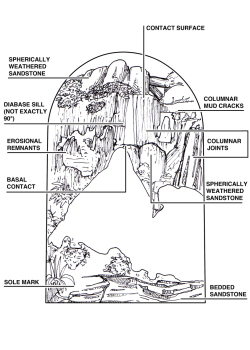Glossary
basal contact- lower plane where two different types of rock come in contact with each other.
bedding- planes dividing sedimentary rocks of the same of different rock types.
contact- upper plane where two different types of rock come in contact with each other.
diabase- a rock of igneous (volcanic) origin, dark in color, very hard, with low permeability
dip- angle at which rocks are found.
erosional remnants- rocks that, being harder than the rocks lying above or beside them are left behind after other, less resistant rocks are eroded away by water or wind.
glacial lake- a long, deep lake with high, steep walls fed by side streams that enter it from high-level valleys by cascades or steep rapids.
igneous rock- a rock that originated as a result of volcanism and solidified from molten material.
joint- a fracture in rock, generally more or less perpendicular to bedding, caused as a result of cooling of molten rock. Fractures normally occur in parallel patterns.
limestone- a sedimentary rock consisting chiefly of the mineral calcite (calcium carbonate) .
pinnacle- a high tower or spire-shaped pillar.
sfumato- a painting technique that creates a smoky, veil-like surface quality.
sill- an intrusive body of igneous rock of approximately uniform thickness, relatively thin with respect to its lateral extent, that has been emplaced parallel to the bedding of the overlying and underlying rock.
spheroidal weathering- a form of chemical weyyathering in which concentric shells of decayed rock are successively loosened and separated from a block of rock by water penetrating the bounding joints of other fractures and attacking the clock from all sides. This process is similar to the larger scale exfoliation produced by mechanical weathering.

